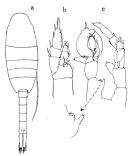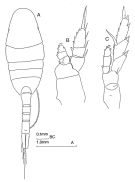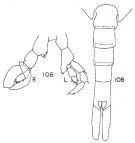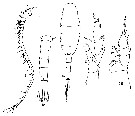|
|
 |
Fiche d'espèce de Copépode |
|
|
Calanoida ( Ordre ) |
|
|
|
Lucicutiidae ( Famille ) |
|
|
|
Lucicutia ( Genre ) |
|
|
| |
Lucicutia lucida Farran, 1908 (F,M) | |
| | | | | | | Syn.: | no Lucicutia lucida : Sars, 1925 (p.219, figs.F,M); Rose, 1933 a (p.194, figs.F,M); ? Mazza, 1962 (p.339); 1966 (p.71); 1967 (p.321, 367, fig.64); Vinogradov, 1968 (1970) (p.268); ? Soenen, 1969 (p.94) | | | | Ref.: | | | Farran, 1908 b (p.62, figs.F,M); Jespersen, 1940 (p.52); Tanaka, 1963 (p.43, figs.F,M, Rem.); Hülsemann, 1966 (p.725, figs.F,M); Bradford-Grieve & al., 1999 (p.883, 945, figs.F,M); Bradford-Grieve,1999 b (p.102, figs.F,M, Rem., figs.177, 191); Boxshall & Halsey, 2004 (p.132: F; p.134: M); Vives & Shmeleva, 2007 (p.338, figs.F,M, Rem.) |  issued from : O. Tanaka in Publs Seto Mar. Biol. Lab., 1963, XI (1). [p.44, Fig.169]. Male: a, habitus (dorsal); b, P1; c, P5 ( blown: 1st basal segment of right leg with a spinous process and a haired protuberance).
|
 issued from : J.M. Bradford-Grieve in The Marine Fauna of New Zealand: Pelagic Calanoid Copepoda. National Institute of Water and Atmospheric Research (NIWA). NIWA Biodiversity Memoir, 111, 1999. [p.104, Fig.68]. Female (from 31°19.5'S, 165°19'E): A, habitus (dorsal); B, P1; C, P5.
|
 Issued from : K. Hülsemann in Bull. Mar. Sc., 1966, 16 (4). [p.726, Figs.106, 108]. Male (from 5°53'S, 79°57'E & 26°06'S, 64°58'E), : 106, P5; 108, urosome (dorsal)
|
 issued from : G.P. Farran in Fish. Ire. Sci. Invest., 1906, II [1908]. [Pl. VI, Figs.16-20]. Female (from 54°57'N, 10°51'W): 16, habitus (dorsal); 19, P5; 20, P1. Male: 17, left A1; 18, urosome (dorsal).
|
 issued from : G.P. Farran in Fish. Ire. Sci. Invest., 1906, II [1908]. [Pl. III, Fig.22]. Male: 22, P5.
|
 Lucicutia lucida Lucicutia lucida female: 1 - Characters following not combined : Prosome about 3 times longer than urosome. Cephalosome with slightly projecting and rounded anterior corners and well developed lateral spinous projections; anal somite about as long as wide; caudal rami 11.7 times longer than wide and bowed outwards at base, leaving elliptical space between rami proximally. 2 - P1 with 3-segmented endopod. 3 - Cephalosome without spinous projections . 4 - Genital double-somite symmetrical (dorsal view). Anal somite almost as long as caudal ramus. 5 - Anal somite slender.
|
 Lucicutia lucida Lucicutia lucida male: 1 - P1 with 3-segmented endopod. 2 - Cephalosome without lateral projections. 3 - Right A1 reaching at most 2 segments beyond tip of caudal rami. 4 - Caudal rami at most 7 times longer than wide. 5 - Inner margin of basis of right P5 with spiny process. 6 - Anal somite almost as long as caudal rami; A1 reaching to distal end of anal somite.
| | | | | Ref. compl.: | | | C.B. Wilson, 1950 (p.256); ? V.N. Greze, 1963 a (tabl.2); ? Pavlova, 1966 (p.44); Grice & Hulsemann, 1967 (p.17); Roe, 1972 (p.277, tabl.1, tabl.2); Soenen, 1974 (p.120); Vives & al., 1975 (tab.II); Gaudy, 1975 (p;109, fig.1, respiration); Deevey & Brooks, 1977 (p.256, tab.2, Station "S"); Vives, 1982 (p.293); ? Kovalev & Shmeleva, 1982 (p.84); Roe, 1984 (p.358); ? Pancucci- Papadopoulou & al., 1990 (p.199); Lapernat, 2000 (tabl.3, 4); Holmes, 2001 (p.18); ? Vukanic, 2003 (139, tab.1); Fernandes, 2008 (p.465, Tabl.2); Galbraith, 2009 (pers. comm.); Licandro & Icardi, 2009 (p.17, Table 4); Mazzocchi & Di Capua, 2010 (p.426); Belmonte, 2018 (p.273, Table I: Italian zones) | | | | NZ: | 13 + 2 douteuses | | |
|
Carte de distribution de Lucicutia lucida par zones géographiques
|
| | | | | | | | | | | | | Loc: | | | ? Namibia, off Mauritania - NW Cape Verde Is., Morocco-Mauritania, Canary Is., off Madeira, Portugal, off W Cape Finisterre, off Bermuda (Station "S"), Sargasso Sea, E, Iceland, off W Ireland, Baie Ibero-moroccan Bay, ? Medit. (NW Basin, Ligurian Sea, Ionian Sea, Adriatic Sea), Indian, Bay of Bengal, Philippines, China Seas (Hong Kong, Taiwan), Japan (Sagami Bay), off British Columbia, off Galapagos, Panama, Chile, New Zealand (off NW North Island) | | | | N: | 25 | | | | Lg.: | | | (24) F: 3,5; M: 3,25; (26) M: 3,35; (199) F: 3,65-2,96; M: 3,27-2,96; (909) F: 3,5; {F: 2,96-3,65; M: 2,96-3,50}
| | | | Rem.: | bathypélagique.
Il est probable que certaines identifications fondées sur Sars (1925) et Rose (1933 a) modifient la répartition géographique ci-dessus, notamment en ce qui concerne sa présence en Méditerranée (Cf. Lucicutia pera).
Voir aussi les remarques en anglais | | | Dernière mise à jour : 05/02/2020 | |
|
|
 Toute utilisation de ce site pour une publication sera mentionnée avec la référence suivante : Toute utilisation de ce site pour une publication sera mentionnée avec la référence suivante :
Razouls C., Desreumaux N., Kouwenberg J. et de Bovée F., 2005-2025. - Biodiversité des Copépodes planctoniques marins (morphologie, répartition géographique et données biologiques). Sorbonne Université, CNRS. Disponible sur http://copepodes.obs-banyuls.fr [Accédé le 29 décembre 2025] © copyright 2005-2025 Sorbonne Université, CNRS
|
|
 |
 |








